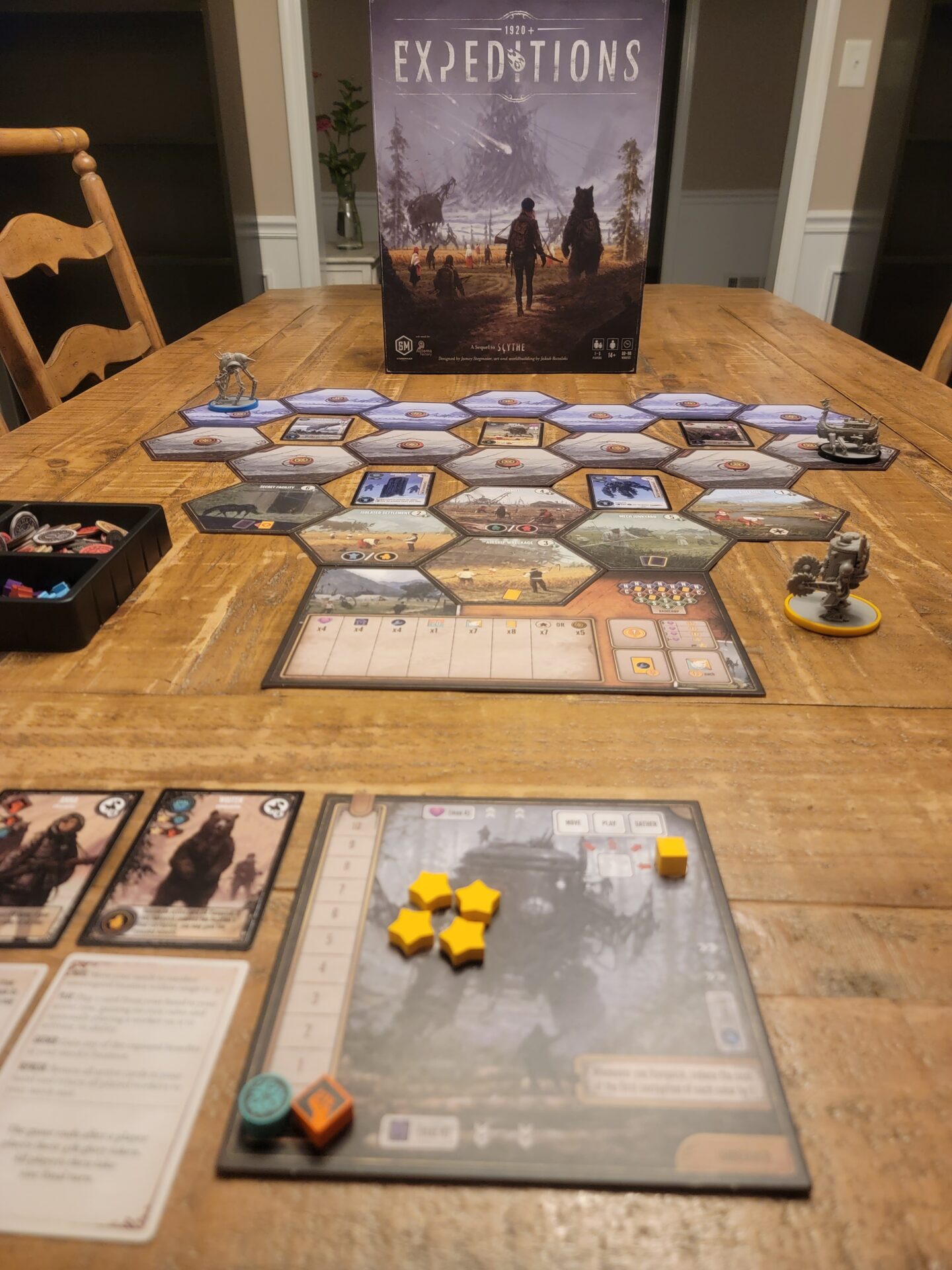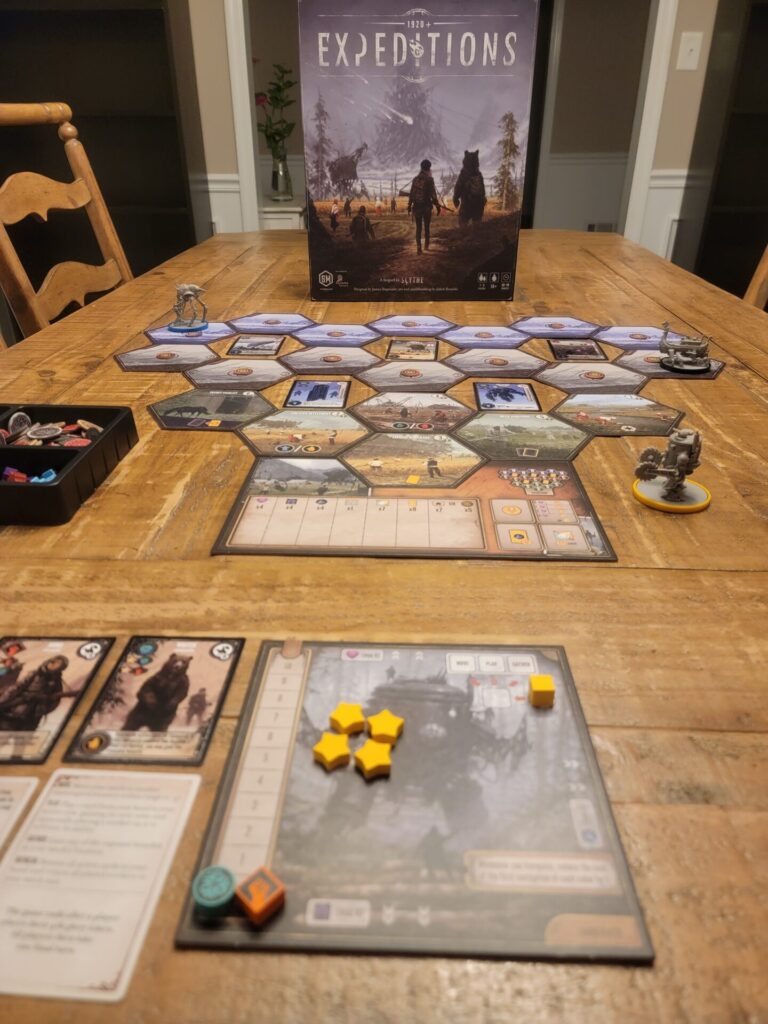
Name: Expeditions
Year of Release: 2023
Player Count: 1 – 5
Playing Time: 60 – 90 Minutes
Designer: Jamey Stegmaier
Publisher: Stonemaier Games
Primary Mechanisms: Hand Management, Grid Movement, Action Retrieval, Variable Player Powers
Weight (According to BGG.com): 2.86
Overview
Obviously, I’m not versed in every board game ever created, but the amount of board game sequels I can think of is… zero. Expansions are so prolific; I don’t think I need to go into any explanation of them. Then there are games such as Caper and Caper: Europe where one is an obvious refinement and improvement over the original concept. But games labeled as “sequels” seem to be underrepresented, though I’m sure after I post this, I’ll think of multiple examples.
When Expeditions was first announced, I was a little skeptical. Scythe is one of the best games I’ve ever played, and would a so-called “sequel” just be a vain attempt to cash off of its good name? Or would the game bring something fresh to the fold, but still pay homage to its source material?
Read on to find out!
Rulebook & Components
At the time of this writing, I own 11 games published by Stonemaier with an additional handful of expansions, and I’d venture to say that I had little to no issues with any of the rulebooks. They are always laid out well, include plenty of examples, and typically include a separate Automa rulebook (if applicable) so as to not cram the solo rules into the normal manual. Unfortunately, the rulebook for Expeditions gets somewhat confusing in the middle, especially on pages six through eight when discussing various Actions. For one, there is a whole slew of definitions on pages seven and nine that I think could have been contained in some sort of side bar. The way they are all thrown right in the middle of the Play description, really makes it difficult for a beginner to get an overhead view of this part of a turn. Looking back on it now, after having played a few times, it makes sense but when I first got to this portion, I was pretty lost.
This happens again a few pages later when discussing the Gather action and some of the benefits that a player will come across when taking this action. These benefits almost seem to be described exactly as some of the card abilities (such as Solve) and until playing, I didn’t even realize these weren’t all activated the same way. Most of the first half of the first game, I was looking for a Solve benefit on the hexagons, not realizing that I was only going to be able to trigger that by playing certain cards, namely my main Character Card. In my opinion, the rulebook would have been more successful for beginners if there was more of a stripped-down example of a turn, with fewer nuances being discussed right up front and then having those different symbols, abilities, and benefits explained later in the manual. I do want to point out that I feel the Automa rulebook is better at describing how the Automa’s turn works and even gives many visual aids to help the solo player navigate how to move the two Automa Mechs through the Siberian tundra.
With the rulebook out of the way, let’s move to the components, where you won’t find a single negative word from me. In normal Stonemaier Games’ fashion, all components (even from the standard version) are out-of-this-world. The five Mech models are bigger than the ones you will find in the original Scythe and come out of the box a neutral grey color (maybe so people can paint them?) To tell which Mech is whose while playing, colored Base Plates are provided that can snap onto the bottom of the Mech, and then match the color of the other individual player components: Glory Tokens and Action Token.
But Expeditions is a game about hand management and exploring unknown tiles so how do these pieces stack up? In one word; amazing. First, if you’ve played (or even looked at) a Scythe product, you’ll know that the artwork by Jakub Rozalski is one of the primary draws. Even if you’re not intrigued by the Steampunk feel of it all, the talent and style of the artist is undeniable. This is no different in Expeditions as each card and Location Tile are lovingly painted to bring the world of Europa and Siberia to life. Second, the sheer scope of having so many individually designed cards is impressive. No, Expeditions isn’t the first game to do this, but having all Item Cards, Quest Cards, and Meteorite Cards (90 in total) shuffled together, knowing each one holds its own little piece of the world, lends an epic feeling when drawing and placing out new cards.
Earlier, I said I wouldn’t say a negative thing about the components, but I guess I do have one small gripe. The game comes with Corruption Tokens that are square wooden blocks, colored either orange or teal (think the same color scheme from The Rise of Fenris) and are printed with a single digit number. These blocks come out of a bag as Central and North Tiles are unveiled and act as a barrier to one of the flipped tile’s benefits. Thematically, this corruption is supposed to have originated when the meteorite crashed near the Tunguska River. For a game series that has such deep worldbuilding, and consistently great miniatures and cards, it’s a shame that this evil corruption is represented by some simple wooden squares. Could they have not at least have been meteor shaped or could the squares have had some artwork or color-scheme to make them feel more… corrupted? Obviously, this is a small matter amongst a game full of great components, but I do feel it is a tiny stumbling block in the otherwise exceptional art design. Enough when the components, let’s see how the setup and gameplay work!
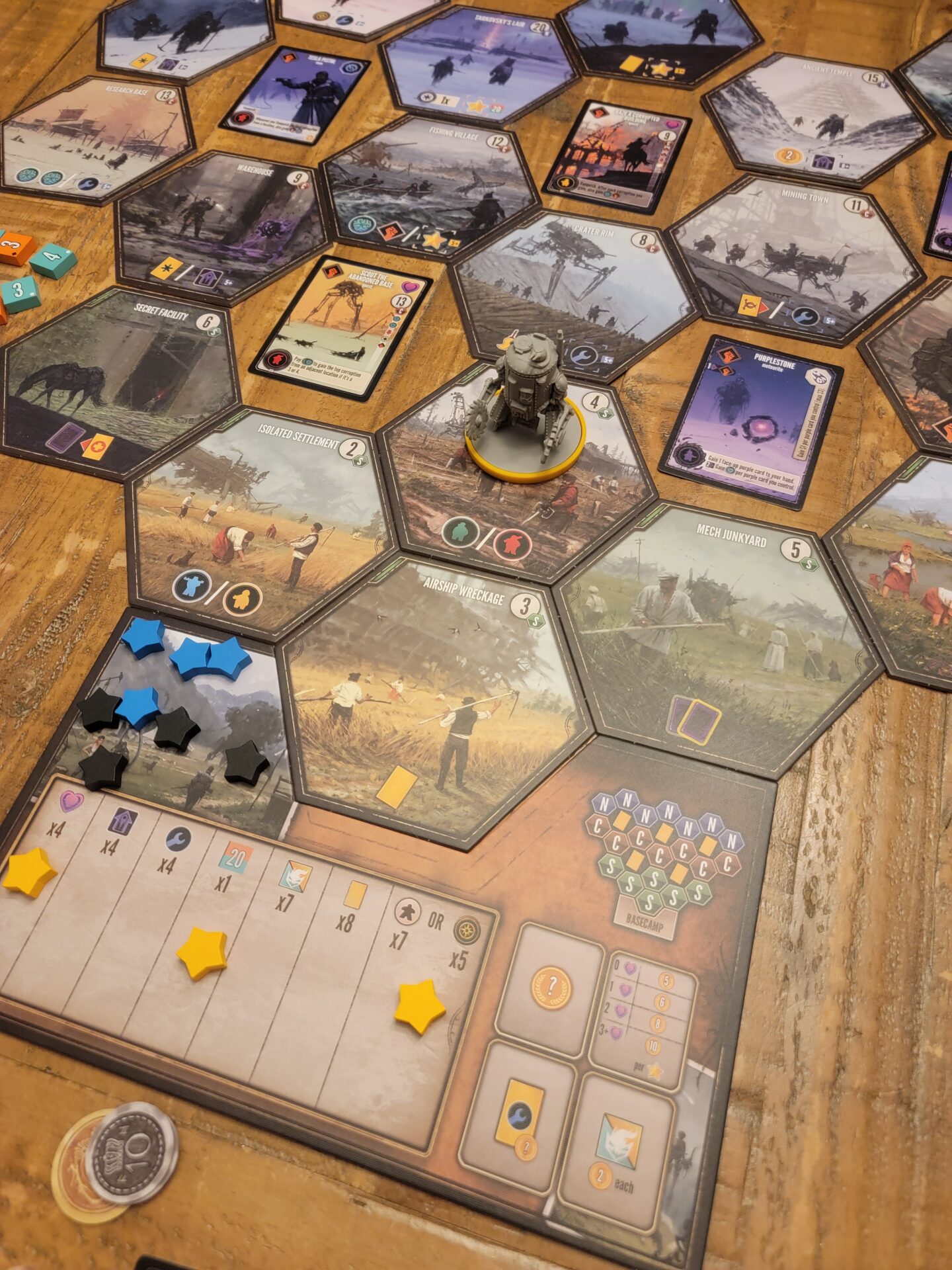
Setup
Much to my wife’s consternation, when I put away a game, I insist that every “type” of component be grouped together and put into a tiny bag and honestly, I feel like a majority of gamers do this too. Even with my preference being known, I have to say that setting up Expeditions is a breath of fresh air because many of the components are just jumbled together in the box and that is ok! For example, there is a small tray with three slots. You can literally take the 50 worker meeples (made up of five different colors) and just dump them right into a slot! Oh, there are 80 cardboard coins in five different denominations? Let’s just throw those together in another slot! And the best part is that this little tray can just be pulled out of the box and placed on the table, ready to go. Additionally, every card (except for the 12 Starting Cards) are shuffled together into one giant pile so you don’t even have to split those up. Lastly, the 37 Corruption Tokens are all just placed into the Corruption Bag so there isn’t really anything to do there. It’s all just so liberating!
About the only part of setup that takes any time is laying out the 20 Location Tiles. These are hexagonal tiles that are split into three districts, South, Central, and North, and are laid out to match the diagram printed in the top right corner of the Basecamp Board. The six South Location Tiles are placed face-up, while both the Central and North Location Tiles are placed face-down with a Map Token put on each one. Once the tiles are laid out in the correct configuration, players will have five open spaces between tiles where they will flip over five cards at random and place them there face up.
Lastly, players will need to figure out which Character, Mech, and color they are going to be playing as. There are five Mech Boards that can be shuffled and then drawn at random, assigning one Mech to each player. You can also shuffle the six Starting Character Cards and deal one to each player. The player will then need to find the matching Starting Companion Card so that they start with two cards in their hand at the start of the game. Players choose a color, grabbing the right Colored Base Snaps to pop onto their Mech as well as their Glory Tokens, Action Cube, and one of each of the Power Tokens and Guile Tokens. At this point, the northern lands of Siberia are ready to be explored!
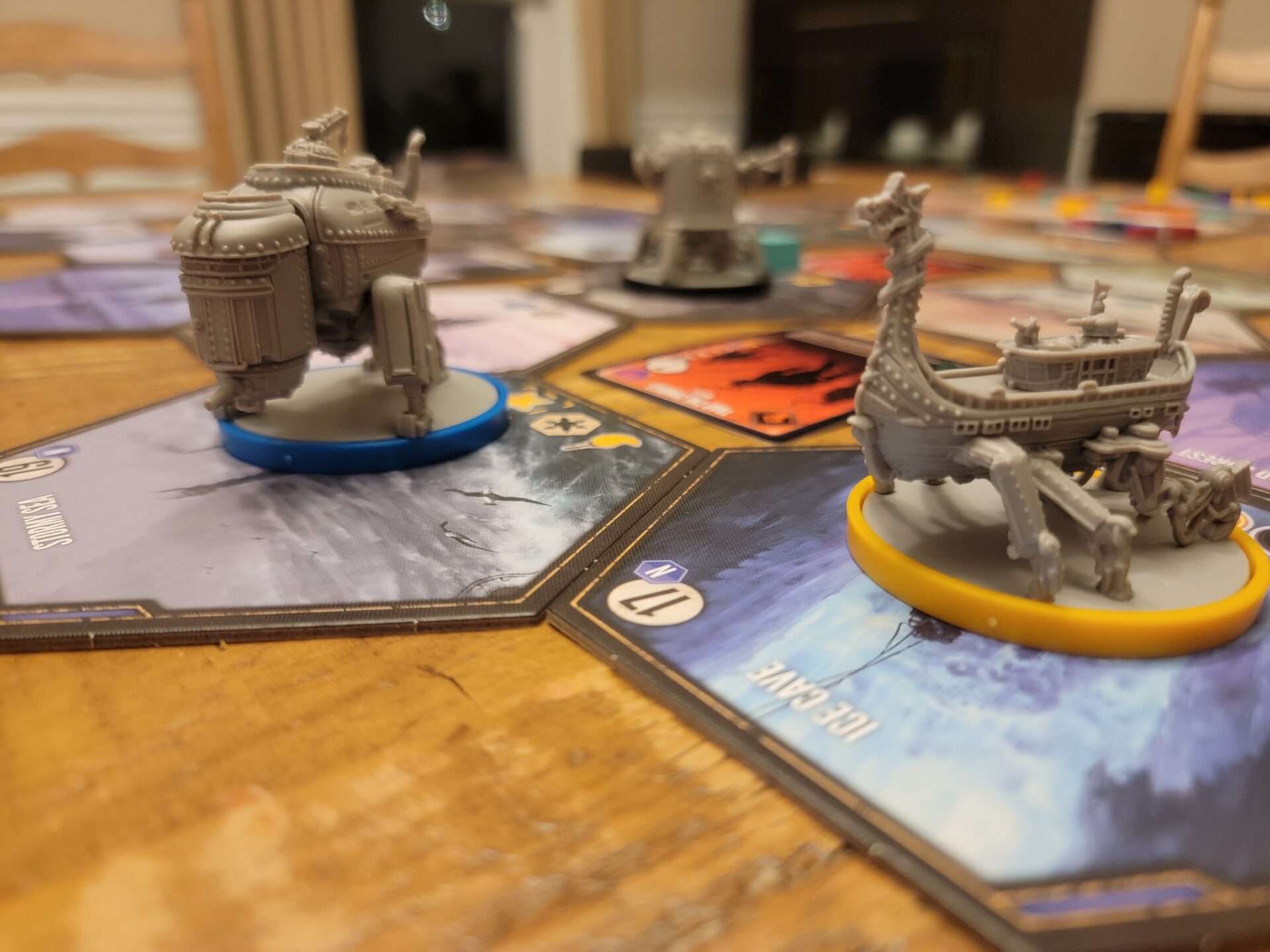
Gameplay
Right off the bat, let’s get it out in the open that Expeditions is not Scythe. There is no combat and very little player interaction at all. There’s no area control nor is there any buildings to construct or Mech abilities that need to be unveiled. There are a lot of little callbacks to Scythe though, but they are implemented in a totally different way in Expeditions. So, let’s start out looking at how a normal turn might play out and then we’ll hit the outlier turns after that.
Most turns, a player will take the Action Cube and cover one of the three different actions, leaving the other two uncovered. These three different actions are Move, Play, and Gather. Whichever two actions are left uncovered are the two actions that the player is going to employ that turn; using them in whatever order they want. The Action Cube must be moved each round though so players can’t take the same two actions on two consecutive turns.
Move is the simplest action and allows a player to move their Mech from one to three hexes with only two real stipulations. The first is that a player cannot end their movement on a hex already containing another player, though they can pass through a hex with another player on it. The second rule is that if a player moves onto a Central or North hex that is still face down, they must stop their movement, taking the Map Token into their inventory and flipping the Location Tile over.
The second action is the Play action and enables players to use the cards in their hand. And by hand, I mean the area to the left of the Mech Mat where you store your cards. Yes, Jamey decided to use the phrase “in your hand” multiple times in the rulebook but players never actually put their cards into their hand. For some reason, this seems to have really ticked off people across the World Wide Web but honestly, it’s not a big deal. When taking the Play action, players will move a card from the left side of their mat to the right side, forming a row called the Active Row. Please note that it is important to put these in a physical row in the order you play them as sometimes cards can interact with the cards around them. All of the cards (no matter the type) have a Core Value in the top left corner, typically either the icons for Power or Guile. When a card is played, you will adjust your Power or Guile meter on your Mech Mat accordingly. You may additionally place a Worker on the card to trigger any additional abilities, but the Worker must match in color with the required color on the card. This part is optional so even if you don’t have any of the correct Workers on your Mech Mat, you can still Play the card to gain the Core Value.
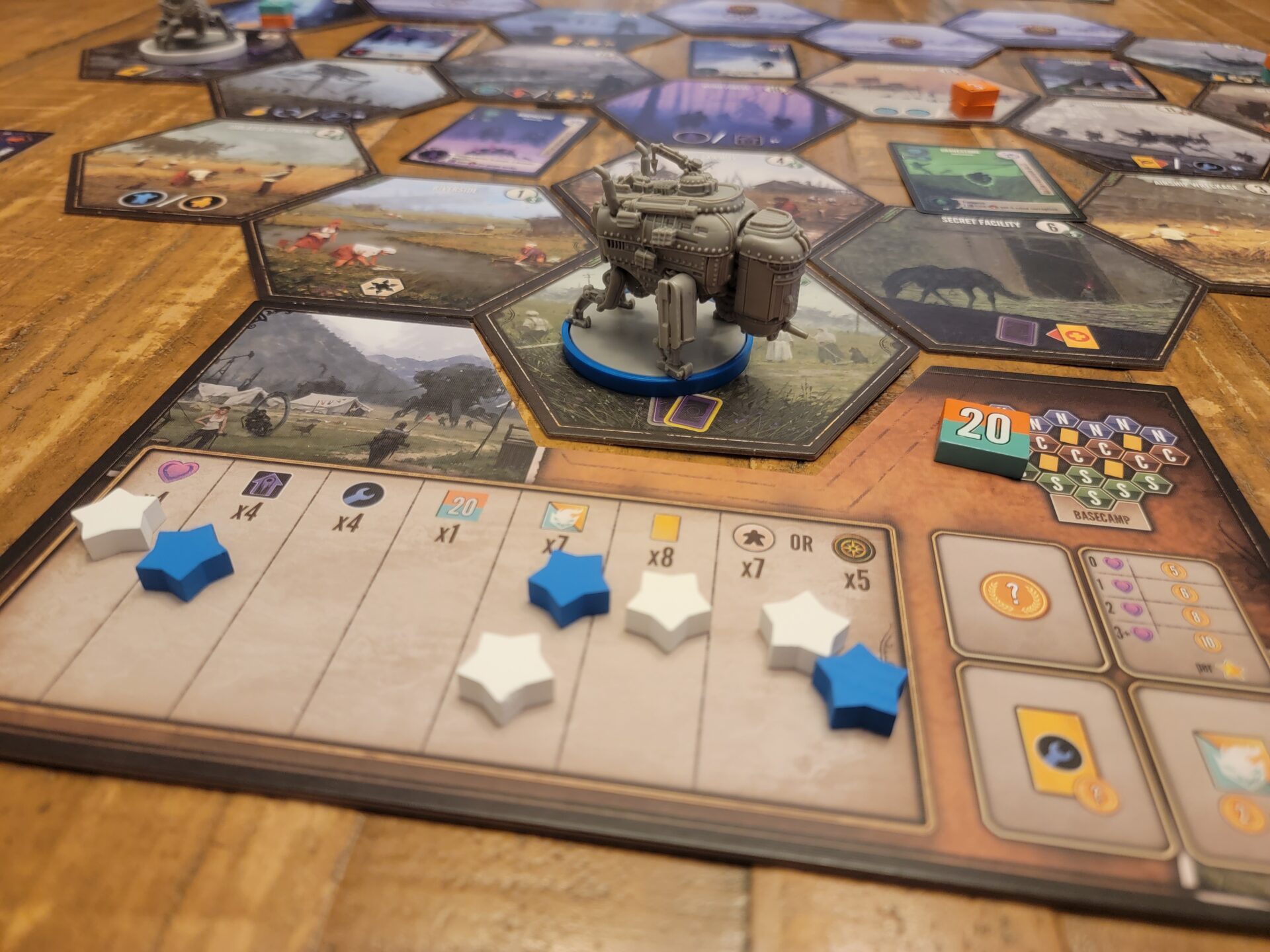
I do want to touch on two abilities that seem only possible if you Play cards containing these abilities. The first is the ability to Solve a Quest Card. These Quests are found spread out within the deck of cards, along with both Item Cards and Meteorite Cards. Quests instruct the player to move their Mech to a specific numbered Location Tile somewhere on the board. Once there, the player can Play a card with the Solve ability (such as your Starting Character), pay the required Power/Guile listed on the card and then gain the reward. Lastly, the card is tucked behind the top of your Mech Card to be used towards gaining a Glory Token, which we will touch on later.
The second ability that players will need a card to enable is the Vanquish ability. Vanquish is needed to get rid of the Corruption Tokens that are going to appear on the Central and North Locations as the game progresses. Earlier I mentioned that when a player moves onto a hidden tile, they have to stop their movement and flip it over. Typically, these locations are going to show two different Benefits, with one being inside a dotted square box with a number to the right of it, usually a “5+” or “8+”. The player will then draw Corruption Tokens out of the bag and place them on this spot until the combined values of the tokens is equal to or greater than the value printed on the tile. So, what does this have to do with the Vanquish ability? The Vanquish ability is how a player is going to pay Power or Guile to remove these Corruption Tokens from the tile, allowing future inhabitants of the tile to use these unlocked Benefits.
The last “main” action is going to be the Gather action, and this is how players interact with the aforementioned tile Benefits. There are a lot of Benefits, ranging from gaining Workers, to drawing face up cards from the board, to replicating adjacent Benefits, so I won’t go into them all here, but I do want to single out three of the most important. The first two are the Upgrade and Meld benefits. Much like Solving a Quest card allows you to tuck it under your board, these two abilities let you tuck Item and Meteorite cards under the right side and bottom side of your board, respectively. Item cards typically give you an ongoing ability and Meteorite cards typically award you with Coins based on certain criteria at the time of Melding the Meteorite card.
The last Benefit I want to touch on is the Boast benefit. Much like in Scythe, players want to meet certain goals and track these goals using the star tokens, called Glory Tokens in Expeditions. Unlike Scythe though, players can’t just place a Glory Token whenever a goal is met but instead have to move their Mech onto a tile with the Boast benefit and then Gather that benefit. This definitely adds a new layer to scoring goals, especially since the Boast benefits are hidden under Corruption Tiles so there is a chance that one player Vanquishing Corruption and unlocking this benefit is going to actually help the opposing player(s).
Eventually, players are probably going to have Played all their cards, leaving no useable cards on the left side of their mat, or maybe they’ve used up all of their Workers and want to bring them back home to re-assign them to new cards. If this is the case, the player will move his Action Token to the Refresh spot on the Mech Map. For this turn, the player moves all their cards from the right side of the mat back to the left side and resets all their workers. While this is all they do in this single turn, they are rewarded on the next turn where they can then trigger all three of the main actions (Move, Play, and Gather) in a single round. Subsequent rounds will have the player move the cube up, blocking one of the three actions, thus beginning the cycle again where this section started.
I absolutely love games where players can chain card abilities together to pull off some pretty wild turns, and Expeditions has this in spades. Yes, the beginning of the game can start slow, since you only have two cards to use, but many of the South tiles give you the ability to gain more cards pretty rapidly. The slow start also doesn’t feel as slow as it might since turns can go by very quickly since there are typically only two actions to activate. While the low player interaction doesn’t bother me, I do think this might be one of the sticking points for some people. When my wife and I played, I almost never really cared where she was moving to, though I will admit there were times when she took a tile and an action (such as Boast) that I wanted and delayed me taking it for another turn. I would also encourage groups who have a sluggish time learning the rules to push through until it all clicks. The Abilities versus the Benefits, the cards on the table versus being in your hand and Upgrading and Melding might all felt a little clunky at the beginning of play, but we eventually found our flow and fell into the groove of the game, enjoying our time in the frozen wasteland of Northern Europa.
Solo Mode Thoughts
I want to, very quickly, give a shout out to the Automa mode packaged with Expeditions. I personally think that this is a fantastic way for someone to learn the game before teaching it to others. The player’s turn is really no different than in a multiplayer game so you will get plenty of learning time in. The Automa’s turn is managed by flipping a card, that instructs where to move two (yes, two) opposing Mechs. One ends up lumbering around the Central tiles while the other stomps back and forth on the North tiles. These Automa’s end up just gobbling up Map Tokens and Corruption Tiles as the game progresses so it’s best to try to get your goals triggered early. If you’ve ever played any of the Automa modes that are usually packaged with Stonemaier games, you’ll feel right at home with the solo mode of Expeditions.
Conclusion
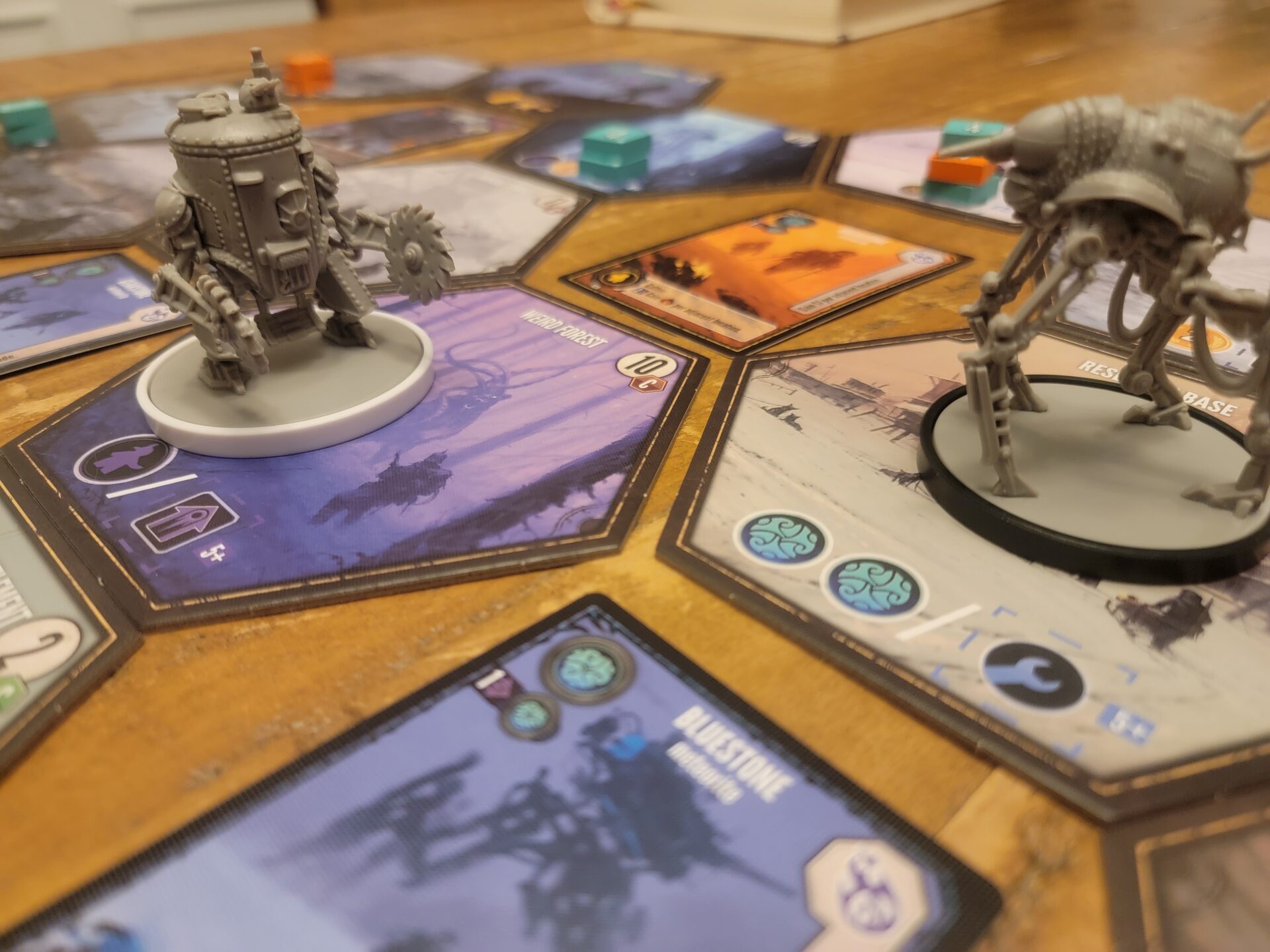
Expeditions is a treat to play. While I don’t think it will be as ubiquitous as Scythe, I think that Jamey Stegmaier should be commended on designing such a different style of game (from its predecessor) that somehow still feels firmly planted in the world of Europa. I hope if people find fault with the rulebook or how the mechanics initially work together, that they push on just a little bit further through the difficulty in order to discover the vast potential that Expeditions has to offer its explorers.
Rating
Ratings are based on 5 main criteria: rulebook, setup, components, art & graphic design, and gameplay. The first 4 criteria are rated 1 to 5 and the gameplay is rated 1 to 10. These scores culminate in an “overall satisfaction” score that is rated from 1 to 10. If the reviewed game has both a solo and multiplayer mode, I have assigned scores separately to give context to which mode we enjoy more.
Links
As an Amazon Associate I earn from qualifying purchases.

